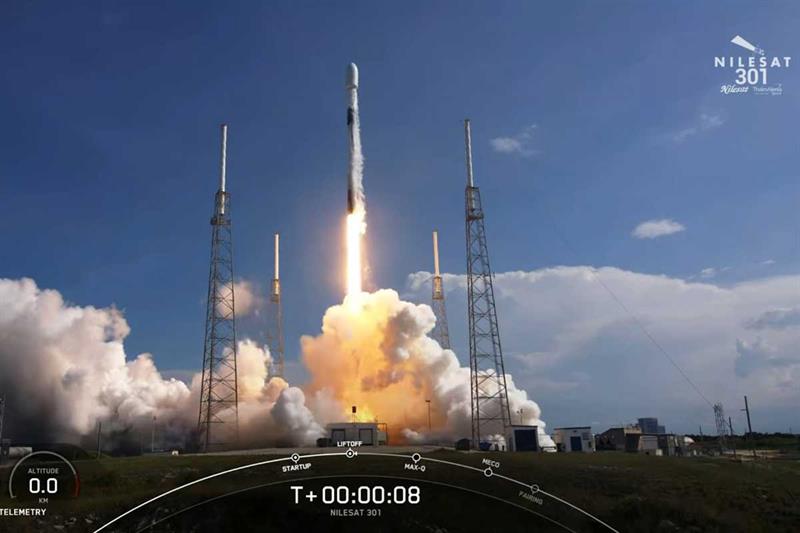
Egyptian saltellite Nilesat 301 launched on board of a SpaceX Falcon 9 rocket from Space Launch Complex 40 (SLC-40) at Cape Canaveral Space Force Station in Florida, US, at 11.04pm Cairo time, 8 June 2022. SpaceX
The geostationary communications satellite, weighing about four metric tonnes, was launched from Space Launch Complex 40 (SLC-40) at Cape Canaveral Space Force Station in Florida, the United States at 11:04pm Cairo time.
The satellite, manufactured by Thales Alenia Space via a joint venture between Thales (67 percent) and Leonardo (33 percent) for the Egyptian operator Nilesat, has finished the required tests, including the in-orbit acceptance tests.
Nilesat 301 has a projected lifespan of at least 15 years and replaces Nilesat 201, which will expire in 2028.
The new satellite will provide expanded broadband internet services covering Egypt, including remote areas, new projects, infrastructure projects, and new urban communities, as well as gas and oil fields in the eastern Mediterranean, Nilesat CEO Ahmed Anis has said.
The satellite will reinforce Nilesat commercial leadership in broadcast services over MENA region and opening new services over southern Africa and Nile Basin, according to Thales website.
“Nilesat 301 is able to maneuver antennas to adjust coverage areas in accordance with the needs of African countries, which are considered new markets for Nilesat,” Anis added.
The new satellite includes 38 transponders compared to 26 transponders in the current Nilesat 201, which was also manufactured by Thales Alenia Space.
Moreover, Nilesat 301 will be able, along with the Egyptian satellite Tiba 1 launched in November 2019, to provide and ensure the continuity and stability of the satellite internet service.
The new satellite’s advanced technology enables it to identify interference sources alone and handle satellite jamming.
The Nilesat 301 took around two and a half years to be manufactured, according to Anis.
Egyptian satellites - A brief history
In 1998, Egypt became the first Arab country to launch a telecommunications satellite into space with NileSat 101. It was followed by Nilesat 102 in 2000, which distributed hundreds of satellite TV channels.
In 2007, Egypt launched EgyptSat 1, which became the first Egyptian remote-sensing satellite and was manufactured in cooperation between Egypt’s National Authority for Remote Sensing and Space Sciences (NARSS) and Ukraine’s Yuzhnoye State Design Office.
Egypt’s second remote-sensing satellite EgyptSat2 was launched in April 2014, but was lost in space in February 2015. Four years later, Egypt replaced it with EgyptSat A after launching it from the Russian Baikonur Cosmodrome, a spaceport in Kazakhstan leased to Russia.
In August 2019, Egypt established The Egyptian Space Agency, as a public economic authority with a legal standing under the direction of the president.
The agency aims to create, transfer space technology development, localisation and own self-capabilities to build & launch satellites from Egyptian territory.
By 2019, Egypt had successfully launched the telecommunications satellite Tiba 1 into space after postponing the launch twice due to technical difficulties.
Minister of Higher Education and Scientific Research Khaled Abdel-Ghaffar stated in mid-2021 that Egypt is scheduled to launch two remote sensing satellites in 2022, asserting that the country will spare no effort to promote multilateral cooperation in the space field.
Short link: